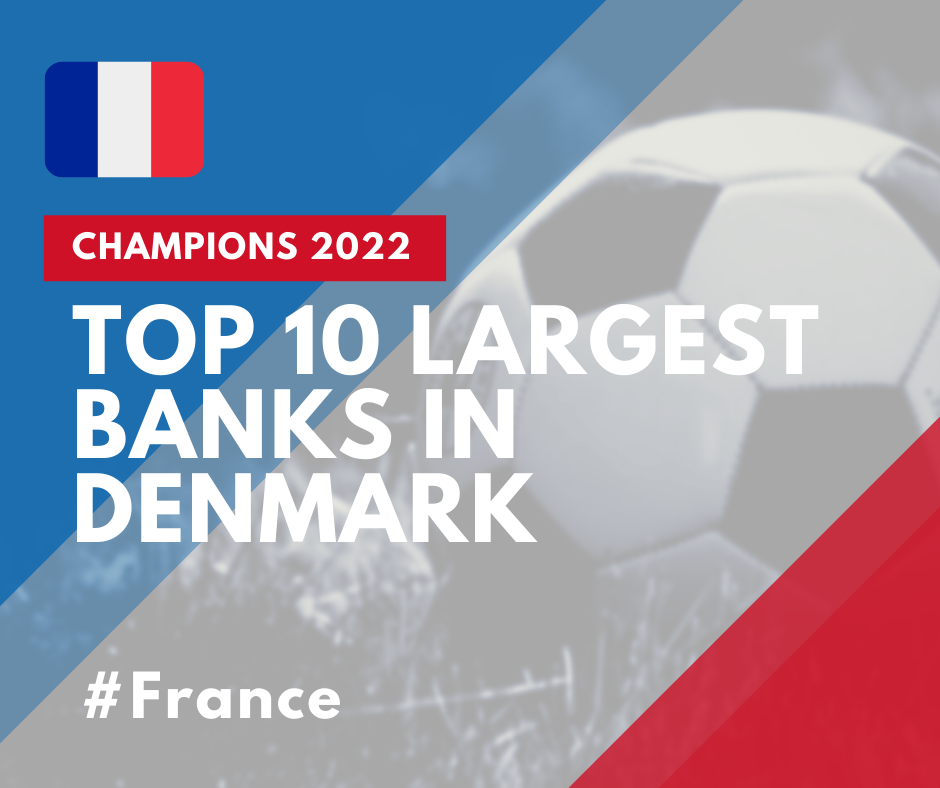Top 10 Largest Banks in Denmark

Due to the fact that the ratio of consolidated banking assets to GDP makes the sector three times larger than the entire country’s economy, the banking industry in Denmark has been described as being enormous and diverse. There are a lot of minor banks and a few international firms in the Danish banking industry. There will be 160 banks registered in Denmark by the year 2020.
Also Read: –Top 10 Banks in Australia 2022
Denmark has a sizable banking industry. The sector is three times larger than the country’s economy based on the ratio of consolidated banking assets to GDP. Danish domestic banks control 87.52% of the total assets of the sector, compared to international banks’ 12.48%.
The banking industry in Denmark is highly concentrated, with the three biggest banks—Danske Bank, Nykredit Realkredit, and Nykredit—controlling 50% of the nation’s total banking assets.
Domestic banks have 87.52 percent of the sector’s total assets, while foreign banks hold the remaining 12.48 percent. More than 50% of the total banking assets are in the ownership of the three biggest banks, with the remaining 40% divided across 67 banks, 27 of which are foreign.
The Danish central bank, which is tasked with stabilising the financial system and ensuring that used payment methods are secure and safe, regulates all banks.
List of Top 10 Largest Banks in Denmark
- Danske Bank
- Nykredit
- Jyske Bank
- Nordea
- DLR Kredit
- Sydbank
- Arbejdernes Landsbank
- Saxo Bank
- Alm. Brand Bank
- Spar Nord Bank
-
Danske Bank
Danske Bank is currently the biggest bank in Denmark, with $558 billion in assets and $137 billion in deposits. Through 234 branches, the bank serves more than 2.8 million customers in 16 countries. Banking DK, Banking Nordic, Corporates and Institutions, Wealth Management, Northern Ireland, and Non-core unit are the divisions through which the bank conducts business.
Danske Bank, which has its headquarters in Copenhagen, provides a range of financial services to its customers. Savings accounts, current accounts, and lending facilities are some of these services. This bank was one of the Fortune 500 firms in 2011. This Bank was established in 1871, but it wasn’t always what it is now. Danske Bank has undergone a number of changes since then, with the most recent one occurring in 2000.
In addition to its operations in Denmark, Danske Bank is well-established in Finland, Sweden, and Norway, three additional Scandinavian nations. Additionally, it runs in Ireland. Danske Bank had a number of activities in Russia and the Baltic states before 2019. However, due to issues with money laundering in Estonia, this bank was forced to close.
-
Nykredit
This is Denmark’s second-biggest bank in terms of assets, and it is acknowledged as the market’s largest lender with a market share of over 32% and a top mortgage lender with a market share of 41%. It works through the following subsidiaries: Nykredit Realkredit, Totalkredit, Nykredit Bank, Nykredit Maegler, and Nykredit Ejendomme. This allows it to provide excellent customer service and preserve its position. With assets totaling $232 billion and mortgage loans valued at $196 billion as of the end of 2019, the group had a profit before tax of $1.4 billion. Its headquarters are in Copenhagen, Denmark, where it was formed in 1985.
-
Jyske Bank
This brings up the list of the top three banks, which as of the end of 2019 had assets worth $94 billion and mortgage loans worth $50 billion. The bank has 3,820 workers and offers goods and services through 99 locations in Denmark, a few in Hamburg, and subsidiaries in Gibraltar. The bank was founded in 1967 and has its main office in Silkeborg. Jyske Bank Ltd., Private Banking Hamburg, and Private Banking Copenhagen are some of its members.
-
Nordea
Nordea is the fourth-largest bank in Denmark with more than 1.7 million household clients and an additional 65,000 corporate and institutional clients. It specialises in mortgage financing, and according to reports, the portfolio of mortgage loans totaled DKK 387 billion at the end of 2018.
Copenhagen serves as the home base for Nordea in Denmark. Additionally, this bank was founded in 1920. It is a part of a network of more than 200 banks with a lengthy history. Nordbanken, Merita Bank, Christiania Bank og Kreditkasse, and Unidanmark all merged into Nordea over the course of four years, from 1997 to 2001. These four banks are all a part of the Nordic region, which consists of Sweden, Finland, Denmark, and Norway.
Nordea offers businesses and institutions a vast array of services in addition to mortgage services. This bank especially maintains close ties with small and medium-sized companies. By offering lending facilities at a competitive rate, it accomplishes this. Similarly, Nordea continues to provide services to individual customers. This financial organisation primarily provides mortgage services to a large number of customers.
-
DLR Kredit
This mortgage credit company concentrates on mortgage lending services with a preference for agricultural and commercial real estate. The bank, which is owned by 58 local and regional financial institutions in Denmark, does not have any physical locations; instead, its mortgage products are offered through the owner banks’ networks. The bank was established in 1960, employs 186 workers, is based in Copenhagen, and has total assets worth $29 billion. In 2019, the bank had total revenue of $213 million.
DLR Kredit earned the designation of Systemically Important Financial Institution (SIFI) in 2016. This indicator displays the bank’s expansion since its collapse, which could have caused economic instability in Denmark. This bank’s success is largely attributable to the significant financial support it provides to the nation’s agriculture industry. The loans that DLR Kredit provides typically include the issuing of covered bonds that are backed by mortgaged real estate.
DLR Kredit provides financial assistance to businesses, including small and medium-sized ones, in addition to agriculture. This bank does not, however, run any branch locations. utilises instead the Danish network of shareholder banks. The bank has no credit risk even if it has received several loans. Due to loss-mitigating arrangements and guarantees the bank has with shareholder banks that disperse loans, this cap has been set.
-
Sydbank
One of the largest banks in Denmark today, Sydbank was established in 1970. This bank was founded as a result of many banks merging. Since its founding, Sydbank has progressively expanded by absorbing numerous additional banks. This bank subsequently listed on the main stock exchange of the nation as it grew.
In addition, Sydbank offers banking services to three different types of customers. Private clients, retail clients, and small to medium businesses are examples of these types of clientele. This bank’s ability to earn from offering these services enables it to give its shareholders a respectable rate of return.
-
Arbejdernes Landsbank
A year after World War I’s conclusion, in 1919, Arbejdernes Landsbank opened for business. The bank now operates more than 50 branches in Denmark. In general, private persons, small enterprises, and medium-sized businesses are the target markets for Arbejdernes Landsbank’s services. Numerous awards have been given to the bank in recognition of its superior services. For ten years running, Arbejdernes Landsbank has received the most votes from customers.
Arbejdernes Landsbank has about 1,000 employees and offers a wide range of banking services, including personal, business, and investment accounts. Over 200,000 customers are served by it through these services.
-
Saxo Bank
In 1992, Saxo Bank opened for business. Midas Fondsmaeglerselskab was the original name of Saxo Bank before it changed to its current name. This bank created an online trading system six years after it was founded. Saxo Bank’s trading technology enables it to offer financial guidance to its clients. Saxo Bank was the name chosen by the organisation in 2001 as it obtained its banking licence.
Saxo Bank offers a wide selection of financial goods to its customers for online purchasing. Bonds, foreign exchange, futures, equities, and many more goods are among these. The bank essentially acts as a broker by providing these services.
-
Alm. Brand Bank
In 1792, Alm. Brand Bank opened for business. It offers its clients a range of banking services. These services, which bring in money for the bank, include insurance, pension plans, and other banking services. Additionally, small to medium-sized businesses and private individuals make up the bulk of Alm. Brand Bank’s clientele. Along with its core services, this bank also provides trading, automobile rentals, and asset management.
Three other subsidiaries are under Alm. Brand Bank. Additionally, the Copenhagen Stock Exchange lists it. Sydbank acquired a sizable portion of this bank’s equity in 2020. It cost somewhere around $300 million. Alm. Brand Bank kept its name, nonetheless.
-
Spar Nord Bank
Danish bank Spar Nord Bank was founded in 1824 and offers both commercial and individual customers banking services. To its loyal customers, it provides services including mortgage credit, loans, deposits, advances, and much more. One of the largest banks in the nation in terms of total assets is this one. Through a Danish financial regulatory body, Spar Nord Bank has been operating as a special financial institution since 2019. At this time, Denmark is home to roughly 80 branches of the bank. Jutland is the home to Spar Nord Bank, which serves more than 300,000 customers.
Spar Nord Bank generated an after-tax profit of more than €68 million in the first half of 2022. High loan activity is what has led to this profit level.







